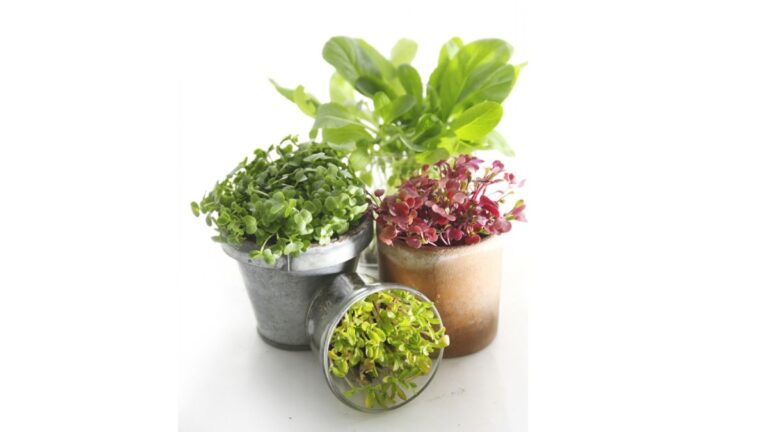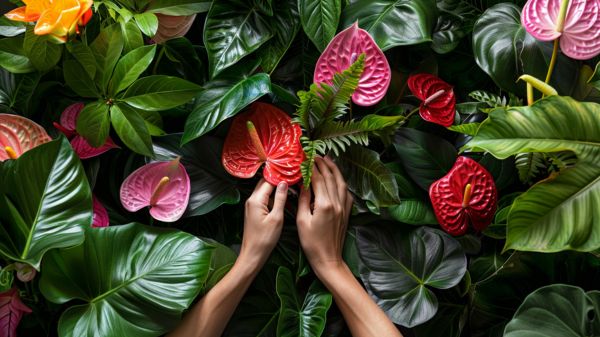10 Best Methods for Indoor Garden Temperature Management
You might be surprised to learn that the comfort of your indoor garden can hinge on something as simple as temperature control. As you nurture your green oasis, it’s crucial to maintain a cozy environment where your plants feel right at home, just like you do. By mastering the 10 best methods for indoor garden temperature management, you’ll create a thriving space where every leaf and petal can flourish.
Whether you’re monitoring with digital tools, insulating your planting areas, or automating your ventilation, each step you take brings you closer to that ideal balance. Remember, your plants aren’t just living decorations; they’re your silent companions, and they rely on you to keep their world just right.
Let’s explore how you can ensure your leafy friends stay comfortable, healthy, and part of your indoor family.
Monitor With Digital Tools
Your indoor garden’s temperature precision hinges on leveraging digital thermometers for real-time, accurate readings. Mastering temperature control is critical—you’re not just raising plants; you’re nurturing a thriving community within your grow room.
To effectively monitor and control this environment, digital tools are indispensable. These devices grant you the power to detect even the slightest temperature fluctuations, which can be pivotal to your garden’s health.
Insulate Planting Areas
Insulating your garden’s planting areas is a crucial step in creating a stable temperature conducive to plant health and energy efficiency. Achieving precise temperature control in your grow area isn’t just about adjusting room temperature; it’s about creating a harmonious environment where every element works in synergy.
Here’s how you can insulate planting areas effectively:
- Utilize reflective insulation materials to direct heat back to plants, optimizing air temperature.
- Integrate thermal barriers around the grow area to reduce heat loss.
- Ensure heating systems are complemented with insulated surfaces to maintain consistent temperatures.
- Apply foam insulation boards beneath planting containers to minimize ground temperature fluctuations.
- Seal gaps and leaks in the garden space to prevent drafts that can alter the microclimate.
Utilize Heating Mats
As you navigate the intricacies of temperature regulation in your indoor garden, consider the strategic application of heating mats for seedling germination.
These mats provide a controlled heat distribution, crucial for maintaining soil temperatures that catalyze root development and plant growth.
Seedling Germination Boost
Heating mats significantly enhance seedling germination by providing a stable, warm environment for your indoor garden.
To achieve this seedling germination boost, you’re focusing on the foundation of successful indoor gardening: creating an optimal environment that nurtures every young plant.
These mats are critical for managing temperature and humidity levels, which, in turn, helps control humidity and promote even growth.
- Consistent bottom heat improves root development
- Uniform temperatures mitigate the risk of thermal shock
- Precise control over growing conditions
- Reduced time to sprout by maintaining ideal warmth
- Humidity retention when paired with domes
Controlled Heat Distribution
While you’re managing your indoor garden’s climate, utilizing heating mats ensures controlled heat distribution directly to your plants’ roots, offering a precision that standard room heaters can’t match.
These specialized mats provide a consistent and regulated source of heating, imperative for maintaining optimal soil temperatures and fostering robust root development.
Tailored to cater to the specific warmth requirements of various plant varieties, heating mats are indispensable tools for temperature control within your plant sanctuary.
Integrating heating mats into your setup complements your room temperature management, working in tandem with air quality systems, like an exhaust fan or Air Conditioning, to create a harmonious environment.
Such a targeted approach to heating circumvents the uneven warmth distribution of ambient methods, ensuring your green companions thrive in a community of care and precision.
Implement LED Lighting
By switching to LED lighting, you’ll directly reduce the heat output in your indoor garden, streamlining temperature control. LED grow lights are a game-changer for maintaining ideal temperature, ensuring your indoor plants thrive without the stress of high temperatures.
Here’s how LED lighting can enhance your indoor garden’s environment:
- Precision: Targeted light minimizes warm air pockets, ensuring even plant growth.
- Efficiency: LEDs offer more lumens per watt, reducing energy waste.
- Longevity: Durable LEDs lower the frequency of bulb changes.
- Control: Adjustable intensities cater to different plant needs.
- Coolness: Lower operating temperatures prevent heat buildup.
Embrace this cooler, energy-efficient technology to foster a sense of community among fellow indoor gardening enthusiasts, as you collectively pursue a thriving, temperature-controlled green haven.
Introduce Air Circulation
To maintain your indoor garden’s climate, air circulation systems play a pivotal role in dispersing heat and ensuring your plants receive fresh air. Strategically placed fans, such as horizontal airflow (HAF) fans, create a uniform distribution of air, helping to stabilize temperature ranges and manage indoor humidity levels.
By investing in proper fan placement, you’re not just preventing heat buildup; you’re also fostering an environment where your plants can thrive.
Precise air movement mitigates the risk of fungal diseases and supports the plants’ need for carbon dioxide. To increase humidity if needed, consider using a portable heater with a built-in fan. This dual function not only warms your garden but also promotes consistent air circulation, essential for robust plant health.
Install Shade Cloths
You can significantly reduce your indoor garden’s temperature by hanging a shade cloth, which allows you to control the sunlight’s intensity and protect your plants from overheating. As an indoor grow enthusiast, you’ll appreciate the technical aspects of shade cloth installation to maintain optimal conditions within your grow room.
Shade cloths are pivotal in mitigating high humidity and temperature swings.
- Select a cloth with appropriate shading percentage for your plants’ needs
- Ensure the cloth is positioned to maximize airflow while reducing light intensity
- Use retractable systems for adjustable sunlight exposure
- Attach securely to avoid sagging and uneven shading
- Monitor temperature changes to fine-tune shade positioning
Regulate With Thermostats
Efficiency in temperature regulation is key to maintaining your indoor garden’s climate, and smart thermostats offer you unparalleled control with their advanced features.
By regulating with thermostats, you’re able to fine-tune the environment to achieve optimal conditions tailored to the specific needs of your plants. Remember, plants have different requirements; some are sensitive to temperature fluctuations, so precision is crucial.
Smart thermostats enable you to create the perfect climate for each zone of your garden, especially when using a portable zone heating system. You can adjust settings to simulate natural temperature cycles, fostering better growth and vitality.
With remote access tools, you’re always connected, ensuring you can respond quickly to any changes needed for your plants’ well-being. Join the community of savvy indoor gardeners who harness technology for lush, thriving gardens.
Employ Misting Systems
Building on your garden’s climate control, misting systems offer an effective way to cool and humidify your space, catering to plants that thrive in moisture-rich environments. These precision-engineered systems disperse a fine mist that helps increase the moisture in the air, fostering a nurturing habitat for your beloved greenery.
By meticulously balancing humidity levels, you ensure that your plants receive the care they need. Consider the following advantages of misting systems:
- Uniform distribution of moisture around delicate foliage
- Reduction of air temperature through evaporative cooling
- Customizable droplet sizes to accommodate various plant needs
- Integration with automated systems for consistent humidity control
- Mitigation of transplant shock by maintaining optimal moisture levels
Employing a misting system is a technical, yet intimate, way to bond with your plants, ensuring they flourish in your expertly managed indoor garden microclimate.
Apply Water Cooling Techniques
You must consider evaporative cooling systems, which utilize the principle of heat absorption by water evaporation to effectively lower ambient temperatures in your indoor garden.
Incorporate water chiller units into your hydroponic setups to maintain optimal root-zone temperatures, essential for plant health and nutrient uptake.
Precise hydroponic temperature control is achievable through the deployment of such water-based cooling solutions, ensuring your plants thrive in an ideal growing environment.
Evaporative Cooling Systems
During the hotter months, incorporating an evaporative cooling system can significantly reduce your indoor garden’s temperature, offering a refreshing environment for your plants to thrive. These systems excel in managing heating and cooling by exploiting the natural process of water evaporation to cool the air.
- Fan-driven air circulation pushing through moist pads
- Portable AC units with built-in evaporative technology
- Automated hydration maintaining consistent moisture for evaporation
- Precision day and night temperature adjustments for optimal plant growth
- Energy-efficient design minimizing the impact on warm temperatures
Rely on evaporative cooling systems to protect your garden from excessive heat. They provide a stable, controlled environment that encourages your indoor plants to thrive, creating a sense of belonging among your indoor garden community.
Water Chiller Units
To effectively manage your indoor garden’s climate, incorporating a water chiller unit can be a game-changer. It precisely controls the water temperature, directly influencing the surrounding air.
Water chiller units are engineered to stabilize temperatures, essential for plants that require specific conditions, particularly during critical stages like flowering or fruiting.
Tropical plants, for instance, thrive when the water is maintained within a tight temperature range. By integrating a water chiller into your hydroponic setup, you’re able to mitigate heat stress and promote a consistent growing environment. This fosters optimal plant health and productivity.
As you strive for a thriving indoor garden, remember that precision in water temperature control is key. Water chiller units are your allies in achieving that level of meticulous care.
Hydroponic Temperature Control
Continuing from the effectiveness of water chiller units, let’s delve into additional water cooling techniques that’ll further enhance your hydroponic garden’s temperature regulation.
You know the importance of keeping your nutrient solution at the right temperature and humidity to ensure your plants experience optimal growth, especially since some varieties you’re growing require higher precision.
Here’s how you can proficiently apply water cooling:
- Utilize inline water heaters with thermostatic controls for consistent warmth.
- Implement a recirculating water system to uniformly distribute cool temperatures.
- Install aeration devices to dissipate heat and maintain oxygen levels.
- Monitor with digital thermometers for real-time adjustments.
- Employ shade cloths or reflective films to prevent extreme conditions from affecting your setup.
Automate Ventilation Systems
With automated ventilation systems, you’ll ensure consistent airflow in your indoor garden without constant manual adjustments. This is crucial when cultivating a variety of herbs and vegetables, as different plants have varying requirements for optimal growth.
By integrating a Through-the-Wall unit with smart climate control devices, such as the Cielo Breez, you can fine-tune the environment to precisely fit your plants’ needs. The system reacts to real-time data, opening vents when humidity levels are too high or securing them against colder temperatures.
Utilize digital thermometers and hygrometers to keep a vigilant eye on your garden’s conditions, while smart thermostats offer remote access, enabling you to adjust settings on-the-go to maintain a steadfast, nurturing atmosphere for your verdant companions.
Conclusion
Managing your indoor garden’s temperature is critical for plant vitality. You’ve learned to deploy digital thermometers and hygrometers for precise monitoring, insulate planting spaces, and harness heating mats for root warmth.
LED lighting can maintain consistent temperatures, while air circulation is optimized with fans. Thermostats, misting systems, and water cooling techniques offer fine-tuning, and automation takes the guesswork out of ventilation.
Apply these methods rigorously to cultivate a thriving, temperature-controlled green space.






